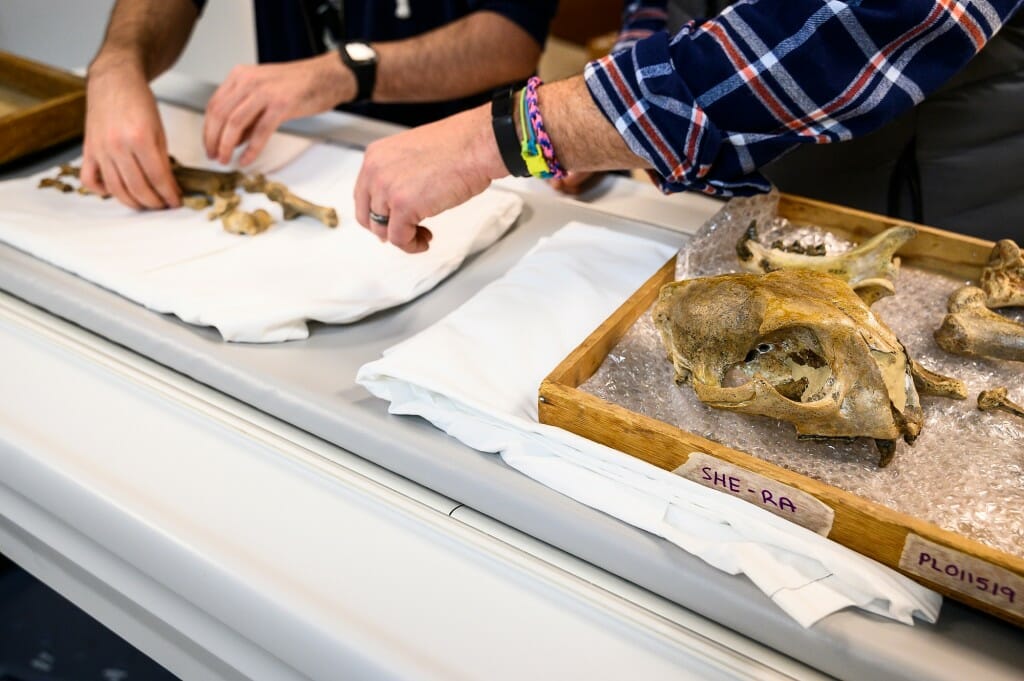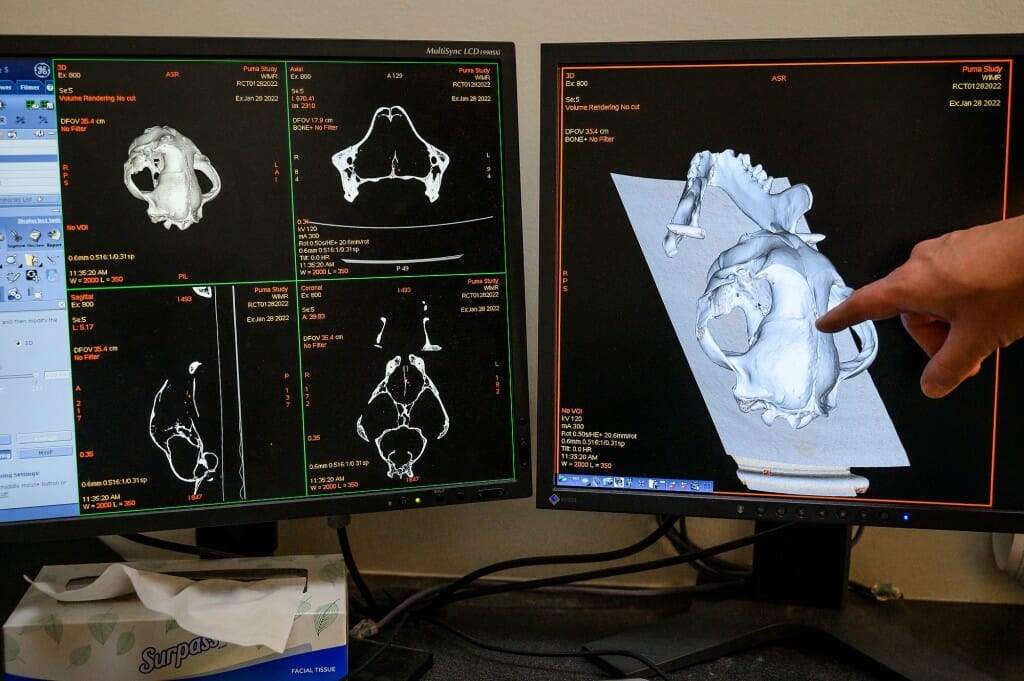The big cat scan: modern radiology meets an extinct American cheetah
About 23,000 years ago, the Bighorn Mountains of Northern Wyoming resembled the landscape of today’s African Serengeti plains.
The Miracinonyx, also known today as the extinct North American cheetah, roamed this region among mammoths, saber tooth tigers and even camels. Imagine an ancient Miracinonyx spotting a pronghorn antelope grazing on the ridge ahead and plotting its plan of attack, unaware that its path will take it through time to a lab at the University of Wisconsin–Madison, where researchers will turn to modern technology to see into the Miracinonyx’s past.
The cat — a lithe 150 pounds, nearly 3 feet tall and twice as long — takes off down the ridge after the pronghorn as it begins to sprint in fear. The pronghorn is, at least in modern day, the second-fastest animal on the planet, so the Miracinonyx must be faster if it wants dinner tonight. But can it keep up? As predator and prey scurry in a high-speed chase, the Miracinonyx is snatched from the hunt when an abrupt 12- by 15-foot cave entrance appears beneath its feet.
Before it can react, our Miracinonyx plummets 82 feet straight down to its death.
At the bottom of the pit, in a pile along with other unsuspecting creatures, the Miracinonyx rots down to the bone, until its complete skeleton is recovered among 40,000 other specimens millennia later by teams of paleontologists.
This unique land formation that took the life of this particular Miracinonyx and so many other creatures is now fittingly known as Natural Trap Cave. Since its discovery in the 1970s, Natural Trap Cave has become a hub for paleontology because of the sheer number of fossils that have been found there. Additionally, the conditions inside the cave are almost like a refrigerator — consistently no more than 42 degrees Fahrenheit with high humidity — making the site ideal for fossil preservation.
“Because it preserves genetic information in the fossil bones, we were able to use ancient DNA to really understand the ebb and flow of gene transfer between these very disparate (arctic and lower 48) populations, which is helping to understand migration patterns and how large populations of animals like horses, camels, and mammoth are affected,” says David Lovelace, a paleontologist at the University of Wisconsin Geology Museum.
In the specific case of the Miracinonyx skeleton, scientists are using the bones to answer questions about the animal’s behavior. Was Miracinonyx a runner like the African cheetah is today? Could a high-speed chase after the pronghorn antelope even be plausible? Evidence from isotope data gathered from the Miracinonyx’s teeth proves that it did indeed consume pronghorn, but it cannot confirm that Miracinonyx hunted pronghorn. Could Miracinonyx have been the fastest mammal to have ever run across America’s land?
In January, Lovelace and fellow paleontologists Aaron Kufner and Tony Hotchner entered the Wisconsin Institute for Medical Research’s Imaging Services Department with boxes full of big cat bones. There, they met up with Ke Li, a professor of medical physics, and graduate student Dan Busch. The team combined forces to make 3D scans of the Miracinonyx bones and two species of other big cat bones, the modern puma and modern cheetah, for the purpose of comparison to Miracinonyx.
The modern puma is the closest relative to Miracinonyx, based on mitochondrial DNA. The modern cheetah is also a close relative; it has an axial backbone which will be useful in comparing the Miracinonyx’s utilization of dorsiflexion, the backward bending and contracting of the foot, and other similarities if Miracinonyx is indeed a runner.
The CT scans, a type of X-ray typically used to get accurate cross-sections of human patients, should give evidence that either supports or negates the hypothesis that Miracinonyx was a runner. By using CT data, the researchers hope to look at one of the forearm bones, the radius, to see if it is locked more like a modern cheetah or more flexible like a modern puma. If locked, the Miracinonyx has the potential to be a runner; if not locked, the extinct cheetah may not have been as speedy as hypothesized.
The paleontologists also have other inquiries about the big cats that the CT scans will hopefully offer insight about. Lovelace and the group will use the information from the scan to plot data points on the animals’ body shape and structure and observe differences between the three species.
This data will go into Dragonfly modeling software and quantitatively compare the curvature of the bones. Without imaging, it is difficult to distinguish the bones just by looking at them. More specifically, they want to view the internal brain cavity and cast the skulls, allowing comparison of cranial nerve placement and where nerves connect to stimulate the nose, eyes, and more.
Looking at this data can help reveal if Miracinonyx had a keen sense of smell or more visual acuity in comparison to the puma.
These projects ultimately contribute to the overall goal of “trying to understand the larger evolutionary history of these cats in North America,” says Lovelace. “It’s going to be complex. And it’s going to be fun to try to tease apart using both what genetic information we have as well as morphological information to test various hypotheses on these partitioning, hunting strategies; and then comparing all of that with paleogeography (where and when the animals are found).”
While the cheetah is known to be fast, paleontology research is often extremely slow. Paleontology is an exciting avenue of discovering more about our history, the creatures around us, and their evolution; but don’t hold your breath. Projects can take a while to complete, and describing a new species can take decades, according to Lovelace.
“I always feel bad,” Lovelace notes. “‘Yeah, hey! Let’s collaborate…but it’s going to be 10 years before we get a paper out.’”
The papers themselves are also lengthy, with his longest coming in at around 60 pages. For the Miracinonyx project, Lovelace hopes to have preliminary findings released within the year, but it will take several for official publications to come out.
However, the CT scan of all the bones — which are on loan from the University of Wisconsin Zoological Museum and the University of Kansas — took only a few hours to complete. CTs can be used for much more than just paleontology or to scan the human body.
In fact, this is not the first time Ke Li and the medical physics team have scanned a unique sample. A variety of industrial materials, cadavers, circuits, and tissue specimens, have all been scanned in the past, and special CTs have even been created to scan live animals.
Ke Li and the team at the Wisconsin Institute for Medical Research’s Imaging Services Department want to raise awareness to this exceptional resource.
“This is really unique, this facility and scanner, because the majority of CTs are dedicated for research for clinical use and for clinical patient imaging,” Li says. “We just hope around campus more users will notice the facility and the opportunity to get imaging non-invasively and get some research done here.”











